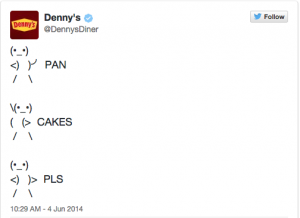I love Denny’s. A hearty bacon and egg breakfast is one of my all-time favourite meals. A Grand Slamwich tastes phenomenal – especially if after a night of drinking. (I’m glad Denny’s is opening up to the fact that being open 24/7 means that many of their late night patrons may be intoxicated). 
With that being said, some of the reasoning behind some of their recent communications campaigns makes perfect sense: when I go to Denny’s, I generally pick between the same two menu items, every single time. Grand Slam or Grand Slamwich. Grand Slam or Grandslamwich. I don’t always browse the menu.
I had seen a couple of the Always Open videos before and I love the concept behind them. Similar in concept to Comedians In Cars Getting Coffee with Jerry Seinfeld, producing viral videos such as these are quite an effective way to connect with the younger audiences and reinforce the Denny’s brand in a subtle way. People love the comedians and actors that are being featured in Always Open, so it wouldn’t be surprising to one day wake up and see a video branded with Denny’s on the front page of Reddit or being shared on my Facebook newsfeed.
Here are a few key takeaways from Jeff Beer’s article about Denny’s content marketing:
- A brand is a feeling, first and foremost – If people aren’t feeling connected to the brand, much of the content you create or communications you release can be meaningless. Understanding how you play a role in the lives of your customers and, thus, how they genuinely feel about you can help dictate the way you communicate with them.
- Social media is used to remind people you’re there, and it needs to be transparent and true. – The worst kind of social media is the type that simply spits out and broadcasts press releases and promotions on the daily. Sure, people love promotions. But promotions won’t explicitly help customers connect with the brand itself. If a brand can release relevant and interesting content, be up to date with pop culture and world events, and actually have a personality, they are generally far more likely to connect with audiences and reach mass appeal. Using Denny’s as an example again: most people probably don’t set up their Twitter accounts with the intentions of following the American chain – but when they release content such as the iPhone mock or responses to major news items, people notice, it gets shared, and their following increases. All of a sudden, Denny’s has an online personality behind it, the brand name is infused in people’s daily digestion of their online social media feeds, and people follow along. Social media can be very powerful when interactive, honest, and full of personality and charm (even if it’s quirky – as long as it’s true and honest). Some more examples of strong brand Tweets can be found here.
- “Read, react, and refine.” Test and monitor very closely. – It’s okay to experiment and take calculated risks with your brand. That was a key takeaway from Beer’s article. What’s important, though, is that these risks are monitored very closely. If something doesn’t seem to be working, the brand needs to react and refine their approach. There’s no sense carrying on with a campaign or a message that doesn’t resonate with an audience. With digital and internet communications being able to be updated almost instantaneously these days, and content scheduled or released hour by hour, a brand cannot wait for month-end reports to roll in before evaluating if a message or approach is resonating. Those working behind a brand need to constantly have their finger on the button and their eyes on the dialogue surrounding what they’ve released. The good news about the internet: feedback can be almost instantaneous.
 Follow
Follow is obviously important for any brand, but it was interesting to see Robertson visually placing “The Mind” first. It’s tough to really drive out large quantities of shoppers if they don’t think about your brand, if they can’t differentiate who you are, and if they don’t recall your brand. Thus, if you’re a brand which consumers are, by and large, indifferent to, then you need to focus on tapping into “The Mind” and “get consumers to think differently about [the] brand.” In order to do this, a company could do something such as launching something new to gain attention or driving a new position in order to shift consumer thought about the brand.
is obviously important for any brand, but it was interesting to see Robertson visually placing “The Mind” first. It’s tough to really drive out large quantities of shoppers if they don’t think about your brand, if they can’t differentiate who you are, and if they don’t recall your brand. Thus, if you’re a brand which consumers are, by and large, indifferent to, then you need to focus on tapping into “The Mind” and “get consumers to think differently about [the] brand.” In order to do this, a company could do something such as launching something new to gain attention or driving a new position in order to shift consumer thought about the brand.






 The company has already been thoroughly analyzed numerous times, as evidenced by reports on the internet. Through our own personal experience and research, we were able to quickly decipher who Zara’s typical consumer segments are and the image they are attempting to achieve in their Promotion (albeit, little promotion) and Place.
The company has already been thoroughly analyzed numerous times, as evidenced by reports on the internet. Through our own personal experience and research, we were able to quickly decipher who Zara’s typical consumer segments are and the image they are attempting to achieve in their Promotion (albeit, little promotion) and Place.